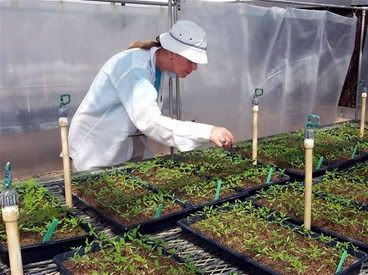The phythium fungus has been the only serious disease we have encountered in our systems, and disease problems have been relatively rare, particularly when all parts of the system are kept covered to keep dust and dirt particles away from the solution. Every plant pathologist on the planet recommends sanitation as the best control procedure for phythium, yet many hydroponic systems are not as well sealed as they should be.
Last year, we discovered that Mn deficiency predisposed the plants to phythium infection. A student worker accidently used MgCl2 in place of MnCl2 for a micronutrient stock solution and we didn't discover the mistake for several months because we were doing short (25 day) studies and there was enough Mn contamination so that no visual symptoms were apparent (growth rate was reduced only about 15% and there was about 10 mg kg-1 Mn in the leaf tissue). During this time several of the systems became infected with phythium. The same systems have never been infected when Mn was adequate. Copper is well known to suppress microbial growth, but increased copper levels are toxic to plants. Manganese and zinc (divalent cations) may have a similar disease suppressive potential, but are less toxic to plants. In the interest of minimizing phythium growth, we have increased solution Mn to a level higher than that required for optimum growth. Careful studies will be required to confirm the beneficial effects of Mn on disease suppression; meanwhile, there is little disadvantage to maintaining manganese, zinc, and copper levels slightly above the minimum required for plant growth.
EXPERIENCES WITH PHYTHIUM CONTROL IN HYDROPONIC SOLUTION
8:59 AM
ThanateTan







